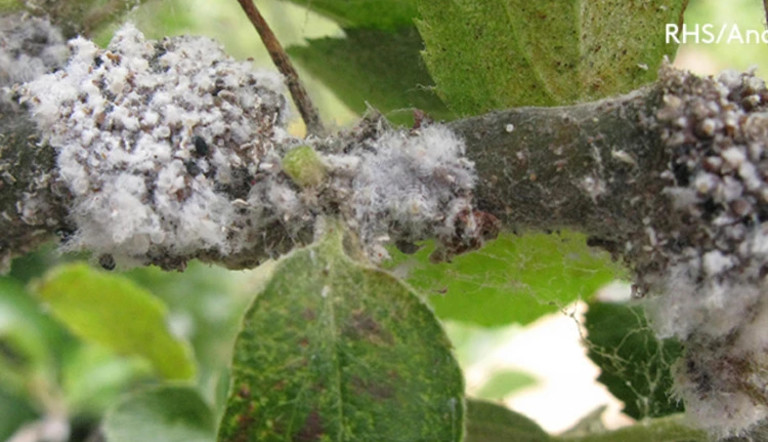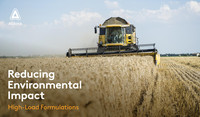
How to minimize the threat of apple and pear pests

Rosy Apple Aphid
Rosy Apple Aphid (Dysaphis plantaginea), and its equivalent the pear bedstraw aphid (Dysaphis pyri), are two of the most damaging top fruit pests. The aphid migrates between plantain and apple or pear trees and attacks all commercially-grown varieties. Symptoms include rosette leaf distortion at the green cluster to pink bud growth stage and later at the end of blossom and early fruitlet development. A spray of an approved aphicide such as Tau-fluvalinate should be applied as soon as infestation is detected and early enough to reach the parasite before it is blocked by cover from distorted mature leaves.
Pear Sucker
Heavy infestations of the Pear Sucker (Cacopsylla pyri) cause extensive damage to the flower stalks and leaves as the adult and larvae feed on the plant sap. Honeydew excreted by the pest acts as a substrate for sooty mould, which is followed by leaf curl, fall and necrosis. The insect secretions cause spots on the fruits which lower their commercial value. Insect predators, such as anthocoris and orius species have been used successfully as biological controls for the Pear Sucker alongside chemical control measures in integrated pest management programmes.
Apple Codling Moth
The Codling Moth (Cydia pomonella) is a key pest, even at low population densities, in both apple and pear orchards. Adults emerge in May to July laying eggs on leaf and fruit surfaces. The larvae hatch after a week and cut into the fruit leaving an entrance hole.
Control measures are implemented once monitoring - using pheromone traps - shows five or more moths per trap, per week between May and June. The threshold is lowered as the fruit softens and becomes more susceptible.
As well as chemical controls like Acetamiprid + Novaluron, biological measures are available such as spraying with a granulovirus or a sex pheromone to disrupt the mating process.
Apple Blossom Weevil
Apple blossom weevil (Anthonomus pomorum) is increasing in importance and is now widespread in orchards, particularly those under organic schemes which do not use chemical control programmes. Apple is the primary host but pear and other top fruit can also be attacked. The typical damage of brown capped blossoms is caused by the larvae eating into the petal bases. Fruit is unlikely to form from these damaged areas.
Monitoring is carried out in the early spring and a broad-spectrum insecticide is used to control populations before eggs are laid and larvae hatch.
Fruit tree red spider mite
Fruit tree red spider mite (Panonychus ulmi) causes, leaf bronzing and apple russeting and is therefore an important secondary pest. The spider mite eggs overwinter on bark around fruiting spurs before hatching in late spring. Up to six generations will be produced during the summer and the freshly-hatched mites attack leaves and trusses. Control can be achieved by introducing the predatory mite Typhlodorums pyri allied with chemical sprays that do not kill the beneficial insect. Where high populations of overwintering eggs occur, a high-volume spray of Apollo can be applied before blossom and before hatching of overwintering eggs begins.
Brown Marmorated Stink Bug
The Stink Bug (Halyomorpha halys), is native to China, Japan, Koreas, and Taiwan but has spread across the world and is now a serious pest in US apple and pear orchards. It gets its name from an odour released from glands on its legs. The female insect which is about 1.5-2cm long, brown and shield-shaped can reproduce even in cooler climates and lays about 400 eggs on leaves. In warmer areas, the bug can produce several generations a year which has led to significant population increases. The bug matures in about 40 days and begins feeding in late spring and early summer using its proboscis to pierce the skin of the fruit. The damage appears as dimpled or necrotic areas on fruit and stippling on leaves, reducing the value of the crop. It also leads to seed loss and can cause lesions and wounds that allow other pathogens to infect the crop. Insecticides are under development.
Woolly Aphid
Large populations of the Woolly Aphid (Eriosoma lanigerum) often occur in growing seasons following warm winters. The brownish, grey-purple aphid appears on new plant growth and can also be identified through its production of white woolly wax secretions.
Inspections for the secretions should take place in June and mid-summer. Once identified control can be achieved using a combination of chemical measures such as Imidacloprid and the release of predator species like earwigs, ladybirds and the parasitic wasp Aphelinus mali.
Apple and Pear Suckers
These small Cacopsylla species like mali in apple and pyricola in pear are about 4mm long and green to reddish brown. Nymphs are paler green with green eyes and emerge shortly after bud burst from overwintered eggs laid on bark.
They can damage crops directly, by sucking sap from blossom trusses and leaf buds, or indirectly by introducing phytoplasma diseases.
The sticky honeydew they secrete after feeding can also provide a good medium for sooty moulds to attach to and develop. However, the waxy blobs of honeydew can act as a tell-tale sign of the flies’ presence and aid control. Insecticides like deltamethrin are effective and should be applied before blossom when about a third of the trusses are infested. Tau-fluvalinate is considered a very effective product to control these pests.
Pear Plant Bug, Green Apple Bug Tarnished Plant Bug
A number of species of the Lygus genus, within the Miridae family, have emerged as serious pests of apple and pear crops, particularly in North America. The adult bugs are a variety of colours from yellow through orange to red and about 7mm long. After overwintering in orchards and on weed plants nearby, the bugs lay eggs in the late spring which then hatch about one month later to release nymphs. Damage is caused to the crop when the insects attack young fruit, piercing it with their mouthparts to inject digestive enzymes. As well as the direct impact of feeding the bugs can act as a vector for disease or leave the damaged fruit more susceptible to pathogens. Control can be achieved through neonicotinoid insecticides in association with mechanical measures like mowing weeds to reduce overwintering sites.



